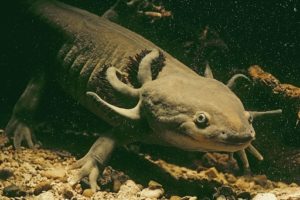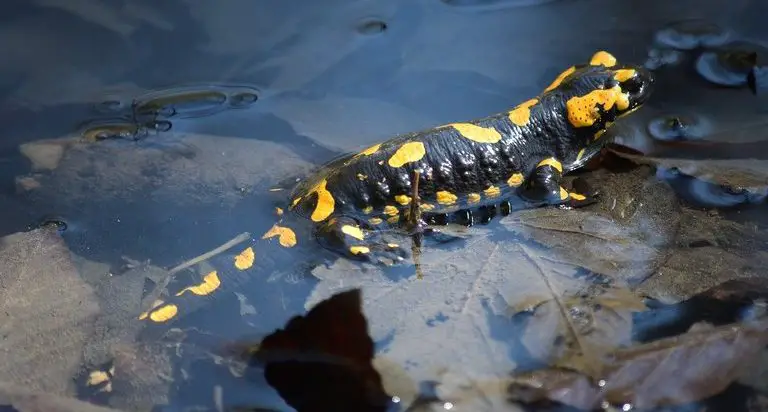Many people know that salamanders need to be around water to keep their skins moist. But can salamanders swim?
All salamanders can swim. However, some salamanders live a mostly terrestrial life and are not the strongest of swimmers. Salamanders typically begin their lives as aquatic larvae with gills for breathing in the water. As they grow, they lose their gills and gain the ability to walk on land.
Some salamanders such as the red-back salamander live their whole lives on land and do not have any aquatic larval stage. Still, even these can swim, but only for short periods of time.
Salamanders Typically Develop in 3 Life Stages
Most salamanders (not all) develop in three life stages. Female salamanders lay eggs and attach them to plants at the bottom of breeding ponds.
After a few weeks, tiny larvae emerge from these eggs. These larvae have external feathery gills and live completely in the water, like fish. As they transform into adult salamanders, they develop lungs and can breathe air.

During these different life stages, salamanders have slightly different swimming abilities.
As Larvae
Larval stage salamanders are very different from adult salamanders. This is because they are adapted for a life in the water, while adult salamanders are not adapted for life on land.
In this stage, they have external feathery gills and live entirely in the water like fish. They also have tiny hind legs, and a flat paddle-like tail fin, to help them move in the water. They swim by flapping their tail from side to side and are excellent swimmers.
As Adults
After a period of a few days to as much as two years (depending on the species), the larvae go through a process known as metamorphosis. In this process, they lose the features that help them live in the water and develop features more suitable for living on land.
During this process:
- The gills shorten and are eventually absorbed into the head
- They develop lungs to breathe air
- The flat tail will thicken and become more rounded
- They develop strong legs for walking on land
In this stage, they are more adapted for a life on land than in the water and are not as strong of swimmers as they were as larvae. Regardless, they can still swim and will typically return to the water to breed and lay their eggs.
Some Salamanders Are Fully Aquatic
Some salamanders such as Axolotls and Sirens live their entire lives in the water. These salamanders do not lose their gills when they develop into adults, so they can breathe underwater just like fish. They also have a flat fin-like tail making them very efficient swimmers.
Some normally terrestrial salamanders can also develop to be fully aquatic. This happens when the larvae fail to transform into adults and become sexually mature while keeping their gills and all their other larval features.

This is known as neoteny and is most common with tiger salamanders and other mole salamanders. It usually happens when the larvae are in a water body with lots of food, making it unnecessary for them to transform into land-dwelling adults.
It can also happen when the conditions on land are particularly harsh, for example, excessive dryness or lack of food, making it necessary for the salamander to stay in the water.
Naturally, neotenic adult salamanders can are very strong swimmers, just like the larvae
How Do Salamanders Swim?
Salamanders swim by tucking their legs against the side of their body and making winding movements with their whole body very similar to how crocodiles or alligators swim. Some species, like paddle-tail newts, have fully webbed feet with very short toes which makes them very efficient swimmers.
Sirens don’t have any hind legs. Instead, they have very strong flat tails that help them swim like fish, with the tail flapping from side to side.
How Long Can a Salamander Stay Underwater?
The short answer is: It depends on how much oxygen it can absorb from the water
Different salamander species have different ways of breathing. Aquatic salamanders have gills that absorb all the oxygen they need from the water. This means they can stay underwater for as long as they like, just like fish.
Salamanders adapted for life on land either have lungs or breathe entirely through their skin (salamanders with lungs still have a limited ability to absorb oxygen through their skin). For these, how long they can stay underwater depends on how much oxygen their skin can absorb from the water.
For example, in crested newts, the extra surface area of skin provided by the large crest allows them to absorb more oxygen through their skin. This means they can stay underwater for a considerable amount of time.
Others such as the tiger salamander only have a limited ability to breathe through their skin, so they can only be underwater for a very short period before they have to surface to breathe air.
As a general rule, salamanders can stay underwater anywhere from a few seconds to several hours depending on the species.
Can Salamanders Drown?
Even with their ability to breathe underwater, salamanders can drown. Remember, they have permeable skins which they use to absorb oxygen from the water. However, the oxygen they get from this is usually insufficient, so they periodically visit the water surface for a gulp of air.
If a terrestrial salamander gets into water so deep that it can not surface or get out of the water, it can drown.
What Salamanders Are the Strongest Swimmers?
Naturally, the more aquatic a salamander is, the better of a swimmer it will be. Salamanders like the red-backed and the slimy salamander are more adapted for a life on land, so they are not the strongest of swimmers.
On the other hand, salamanders like axolotls and sirens are more adapted for a life in the water, making them excellent swimmers.
A simple rule is: The more terrestrial a salamander is, the weaker of a swimmer it will be. Still, even terrestrial salamanders are very decent swimmers.
What to Do if You Find a Salamander in Your Pool
After the rains come, salamanders and other amphibians travel further away from their habitats, and often into people’s yards. When this happens, they can fall into swimming pools with no way of getting out on their own.
Also, the chlorine found in pools can penetrate their absorbent skins and kill them. For this reason, you have to remove salamanders that fall into your pool as fast as possible
You could manually fish them out with a hand net, but this would be hard work because you would have to keep checking your pool for any salamanders. Even worse, the salamander could drown or be killed by the chlorine in the pool before you have a chance to get it out.
The best thing to do is to prevent them from falling into your pool in the first place. You can do this by laying wooden boards around your pool to create barriers. This barrier will act as a ‘wall’ and prevent salamanders from falling into your pool.
Still, some salamanders may be able to pass through this barrier. So you can set up an escape ramp like the Froglog escape ramp (link to Amazon) to help any salamanders that fall to get out on their own.
Frequently Asked Questions
Question: Why do salamanders come out when it rains?
Answer: Salamanders are amphibians with moist absorbent skin which they use to absorb water and other substances. If their skin dries out, they could die.
This makes them limit their activities to times when they won’t dry out, such as when it’s raining and cooler. This is when they migrate to new breeding grounds, look for food or move to new habitats.
Conclusion
Salamanders are amphibians that typically begin their lives in the water. As such, they are natural-born swimmers.
However, as they mature into adults, some salamanders develop features more adapted for a life on land, so they can only swim for short periods. These salamanders spend most of their lives on land hiding in underground barrows, or under rocks and logs, only returning to the water to breed.
Other salamanders develop into adults that live entirely in the water. They have gills, very short legs, and a flat paddle-like tail to which makes them excellent swimmers.


